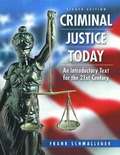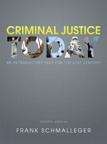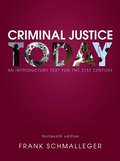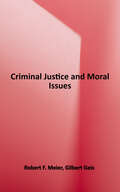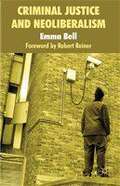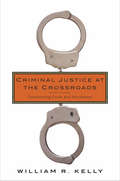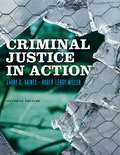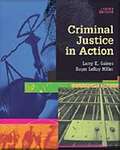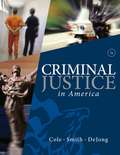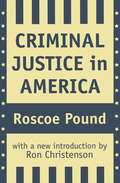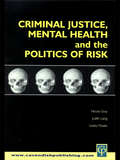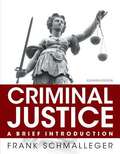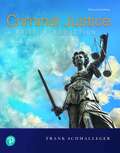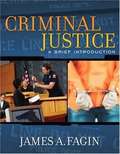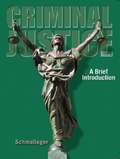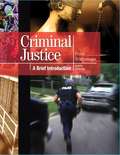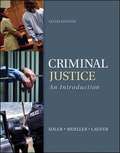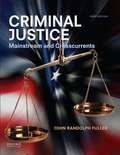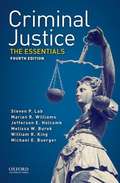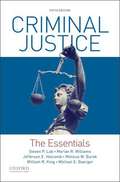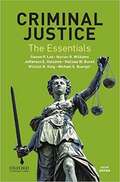- Table View
- List View
Criminal Justice Today: An Introductory Text For The Twenty-first Century (Eighth Edition)
by Frank M. SchmallegerIn a substantially revised eighth edition, Criminal Justice Today continues to set the standard by which all other introductory criminal justice textbooks are measured. The hallmark features that have made Criminal Justice Today the most widely read college criminal justice textbook form the core of this new edition. They include: A thematic approach that contrasts the justice system's twin goals of ensuring public order and safety while guaranteeing individual rights. the book's theme, present since the first edition, is more relevant today and continues to significantly influence the direction of American society. Timely content, including current issues such as efforts to enhance homeland security, concerns about restrictions on individual freedoms in the face of terrorist threats, corporate crime, identity theft, high-technology crime, and special issues such as policing an ever-changing multicultural society. A futures orientation, including a special chapter on the future of criminal justice that points the way to and helps students appreciate the unchanging foundation upon which American criminal justice rests. Accessible technology, including easy-to-use digital tools that make it simple to stay abreast of the latest news, research reports, and government-sponsored studies of relevance to the study of criminal justice. The eighth edition also brings exciting new features to Criminal Justice Today. Among them are: Expanded police coverage, including an entirely new chapter on police organization and management. The criminal justice system's response to terrorism, including broad coverage of homeland security issues, the impact of domestic and international terrorism on criminal justice practices and procedures, individual rights in the face of enhanced security; and terrorism prevention, response, and control. Detailed coverage of corporate crime, including possible criminal activities of companies such as Enron, WorldCom, Adelphia, Vivendi Universal, Kmart, Global Crossing, Tyco International, and London-based auction house Sotheby's. Crime mapping, predictive, and enforcement technologies, including CompStat and CopLink software, wearable augmented reality devices, and biometrics. Expanded coverage of crime scene investigative strategies and techniques, with special graphics provided by the Massachusetts State Police.
Criminal Justice Today: An Introductory Text for the 21st Century (12th Edition)
by Frank J. Schmalleger"Criminal Justice Today," 12/e, continues to lead as the gold-standard for criminal justice texts. Best-selling, student- and instructor-preferred, and time-tested--Schmalleger is the most current and popular text in the market. The text guides criminal justice students in the struggle to find a satisfying balance between freedom and security, and focuses on the crime picture in America and on the three traditional elements of the criminal justice system: police, courts, and corrections.
Criminal Justice Today: An Introductory Text for the 21st Century (13th Edition)
by Frank J. SchmallegerOnce again, Schmalleger is the most current and popular text on the market and continues to lead as the gold-standard among criminal justice texts today! Criminal Justice Today: An Introductory Text for the 21st Century, 13e continues to lead as the gold-standard for criminal justice texts. Best-selling, student- and instructor-preferred, and time-tested-Schmalleger is the most current and popular text on the market. This textbook guides criminal justice students in the struggle to find a satisfying balance between freedom and security. True to its origins, the thirteenth edition focuses on the crime picture in America and on the three traditional elements of the criminal justice system: police, courts, and corrections. This edition continues to question the viability of our freedoms in a world that has grown increasingly more dangerous. Students are asked to evaluate the strengths and weaknesses of the American justice system as it struggles to adapt to an increasingly multicultural society and to a society in which the rights of a few can threaten the safety of many.
Criminal Justice and Moral Issues
by Gilbert Geis Robert F. MeierThis text addresses the following two questions: "What kinds of problems can the law solve?" and "What kinds of problems does the law create?" Using these questions as starting points, Meier and Geis evenhandedly explore the role and function of law relating to six major issues that often divide Americans today: prostitution, drug use, homosexuality, abortion, pornography, and gambling. Statutes and public opinion have shifted dramatically over recent decades in regard to these behaviors. The book details these developments and offers explanations of why they have occurred. Some people view all or some of these behaviors as acts that ought to be permitted, as part of individual freedom. Others find one, some, or all of them to be genuine threats to the country's social and moral fiber and believe that they ought to be criminalized. Still others maintain that action ought to be taken to limit some of the behaviors, but that using the criminal justice system is not the best way to proceed. Meier and Geis' provocative book offers sophisticated, in-depth discussions of these issues, and then reviews the conflicting opinions about the proper role of criminal law in dealing with them. It is written in straightforward, jargon-free language, providing an ideal background for exploring the facts and views regarding what are often contentious concerns. The book increases student understanding through the abundant use of relevant illustrations, examples, and case studies.
Criminal Justice and Neoliberalism
by Emma BellAs criminal justice has become one of the most hotly-debated issues in contemporary Western politics, the punitive capacity of the State has intensified. This book seeks to test the validity of claims that the UK has experienced a 'punitive turn' over the past two decades and to situate recent trends in the specific context of neoliberalism. It is argued that, whilst particular cultural and political factors are relevant, it is ultimately neoliberalism which has led to the recent intensification of punishment, undermining government's capacity to deal with the structural causes of criminality, leading it to use the crime problem as a wedge issue in a vain attempt to appeal to the electorate across class lines and forcing it to submit the criminal justice system, as all other public services, to the processes of commodification.
Criminal Justice at the Crossroads
by William R. KellyOver the past forty years, the criminal justice system in the United States has engaged in a very expensive policy failure, attempting to punish its way to public safety, with dismal results. So-called "tough on crime" policies have not only failed to effectively reduce crime, recidivism, and victimization but also created an incredibly inefficient system that routinely fails the public, taxpayers, crime victims, criminal offenders, their families, and their communities.Strategies that focus on behavior change are much more productive and cost effective for reducing crime than punishment, and in this book, William R. Kelly discusses the policy, process, and funding innovations and priorities that the United States needs to effectively reduce crime, recidivism, victimization, and cost. He recommends proactive, evidence-based interventions to address criminogenic behavior; collaborative decision making from a variety of professions and disciplines; and a focus on innovative alternatives to incarceration, such as problem-solving courts and probation. Students, professionals, and policy makers alike will find in this comprehensive text a bracing discussion of how our criminal justice system became broken and the best strategies by which to fix it.
Criminal Justice at the Crossroads: Transforming Crime and Punishment
by William KellyOver the past forty years, the criminal justice system in the United States has engaged in a very expensive policy failure, attempting to punish its way to public safety, with dismal results. So-called "tough on crime" policies have not only failed to effectively reduce crime, recidivism, and victimization but also created an incredibly inefficient system that routinely fails the public, taxpayers, crime victims, criminal offenders, their families, and their communities.Strategies that focus on behavior change are much more productive and cost effective for reducing crime than punishment, and in this book, William R. Kelly discusses the policy, process, and funding innovations and priorities that the United States needs to effectively reduce crime, recidivism, victimization, and cost. He recommends proactive, evidence-based interventions to address criminogenic behavior; collaborative decision making from a variety of professions and disciplines; and a focus on innovative alternatives to incarceration, such as problem-solving courts and probation. Students, professionals, and policy makers alike will find in this comprehensive text a bracing discussion of how our criminal justice system became broken and the best strategies by which to fix it.
Criminal Justice in Action
by Roger Leroy Miller Larry K. GainesWith riveting examples taken from today's headlines, cutting-edge material on careers, new ways to help students think and write critically, and an engaging magazine-style design, this text is perfect for today's busy students and instructors.
Criminal Justice in Action (3rd Edition)
by Roger Leroy Miller Larry K. GainesThis textbook introduces the criminal justice system and particularly examines the roles played by police, courts, and corrections. Gaines (California State University) and Miller discuss measurements and explanations of crime, criminal law, police organization, pretrial procedures, criminal trials, punishment and sentencing, probation and community corrections, juvenile justice, the drug war, and cybercrime. The fifth edition adds a chapter on homeland security and sections on police strategies, jail overcrowding, and school violence. Annotation ©2008 Book News, Inc. , Portland, OR (booknews. com)
Criminal Justice in Action: The Core (Criminal Justice Ser.)
by Larry K. Gaines Roger LeRoy MillerNIMAC-sourced textbook
Criminal Justice in America (7th Edition)
by George F. Cole Christopher E. Smith Christina DejongThe book is designed to provide thorough introduction and comprehensive coverage to the dynamics of the American criminal justice system and illuminates contemporary issues and problems.
Criminal Justice in America (Quality Paperbacks Ser.)
by Roscoe PoundRoscoe Pound believed that unless the criminal justice system maintains stability while adapting to change, it will either fossilize or be subject to the whims of public opinion. In Criminal Justice in America, Pound recognizes the dangers law faces when it does not keep pace with societal change. When the home, neighborhood, and religion are no longer capable of social control, increased conflicts arise, laws proliferate, and new menaces wrought by technology, drugs, and juvenile delinquency flourish. Where Pound saw the influence of the motion pictures as part of the "multiplication of the agencies of menace," today we might cite television and the Internet. His point still holds true: The "old machinery" cannot meet the evolving needs of society. In Criminal Justice in America,Pound points out that one aspect of the criminal justice problem is a rigid mechanical approach that resists change. The other dimension of the problem is that change, when it comes, will result from the pressure of public opinion. Justice suffers when the public is moved by the oldest of public feelings, vengeance. This can result in citizens taking the law into their own hands--from tax evasion to mob lynchings--as well as in altering the judicial system--from sensationalizing trials to producing wrongful convictions. Ron Christenson, in his new introduction, discusses the evolution of Roscoe Pound's career and thought. Pound's theories on jurisprudence were remarkably prescient. They continue to gain resonance as crimes become more and more sensationalized by the media.Criminal Justice in America is a fascinating study that should be read by legal scholars and professionals, sociologists, political theorists, and philosophers.
Criminal Justice in Divided America: Police, Punishment, and the Future of Our Democracy
by David A. SklanskyHow a broken criminal justice system has fueled the crisis of American democracy, and how we can address both problems together.American criminal justice is in crisis. Prisons are swollen, confidence in police has plummeted, and race- and class-based biases distort every aspect of the system. American democracy is in crisis, too, as the chasm of loathing and incomprehension that divides political factions grows ever wider and deeper. Legal scholar and former prosecutor David A. Sklansky argues that these crises are deeply intertwined. And if the failures of American criminal justice are near the heart of our political divides, then reforming the system is essential for repairing our democracy.Criminal Justice in Divided America shows how police, courts, and prisons helped to break American democracy and how better approaches to public safety and criminal accountability can help to repair it. Engaging critically with concerns from both the left and the right, Sklansky lays out a clear and deeply researched agenda for reforming police departments, prosecutors’ offices, criminal trials, and punishment. Sklansky seeks pragmatic solutions that take account of political realities: the lofty ideal of empowering “the people” or “the community” can mean little when members of the public or the community disagree. While efforts to “defund” the police have exacerbated political conflicts without addressing the underlying problem of how and when force should be used to protect public safety, reforms aimed at improving police accountability, restraining prosecutorial power, and expanding the role of juries can bring together warring parties who share a concern for justice.Ultimately, Sklansky argues, reform must be rooted in a strong commitment to pluralism—bridging political divides rather than worsening them, strengthening democracy, and securing the broad support that enables durable change.
Criminal Justice in Hong Kong
by Carol Jones Jon VaggContaining a wealth of archival material and statistical data on crime and criminal justice, Criminal Justice in Hong Kong presents a detailed evaluation of Hong Kong’s criminal justice system, both past and present. Exploring the justice system and the perceptions of popular culture, this book demonstrates how the current criminal justice system has been influenced and shaped over time by Hong Kong’s historical position between ‘East’ and ‘West’. Jones and Vagg’s examination of the justice system not only takes into account geographical changes, like the erection of the border with communist China in 1950 but also insists that any deep understanding of the current system requires a dialogue with the rich and complex narratives of Hong Kong’s history. It explores a range of questions, including: How were Hong Kong's criminal justice institutions and practices formed? What has been its experience of law and order? How has Hong Kong's status as between 'East' and 'West' affected its social, political and legal institutions? Careful and detailed, this analysis of one of the most economically successful, politically stable and safe yet frequently misrepresented cities, is a valuable addition to the bookshelves of all undergraduate and postgraduate students studying Asian law.
Criminal Justice, Mental Health and the Politics of Risk
by Lesley Noaks Nicola S Gray Judith M LaingCriminal Justice, Mental Health and the Politics of Risk addresses the important issues which lie at the forefront of decision making and policy in criminal justice and health care. The book brings together several perpectives from a number of distinguished academic lawyers, criminologists, psychologists and psychiatrists. It is multi-disciplinary in its approach and is jointly edited by a lawyer, a criminologist and a psychologist - all of whom have expertise and experience in this field. The book is written in the light of the current emphasis on risk assessment and management as well as the recent government proposals to reform mental health law and detain dangerous and severely personality disordered individuals. It provides a theoretical overview for academics and students in the fields of medical law, mental health law, criminal justice, psychology, sociology, criminology and psychiatry. In addition, the book's highly topical and pragmatic approach will appeal to numerous professionals and practitioners
Criminal Justice: A Brief Introduction
by Frank J. SchmallegerThe gold standard for criminal justice texts Criminal Justice: A Brief Introduction, Eleventh Edition offers a contemporary, authoritative look at crime in America with a focus on police, courts, and corrections. To make information resonate with students, Schmalleger asks readers to consider the balance between freedom and security issues and evaluate the strengths and weaknesses of the American justice system as it adapts to cultural, political, and societal changes. An interactive website along with author tweets (@schmalleger) extends chapter material and provides up-to-the minute information on this ever-evolving field. Its unifying theme, unmatched timeliness, and coverage of trends and technology make this text the standard by which all other brief texts are judged. Personalize learning with MyCJLab MyCJLab is an online homework, tutorial, and assessment program designed to work with this text to engage students and improve results. This powerful homework and test manager lets you create, import, and manage online homework assignments, quizzes, and tests that are automatically graded. You can choose from a wide range of assignment options, including time limits, proctoring, and maximum number of attempts allowed. The bottom line: MyLab means less time grading and more time teaching.
Criminal Justice: A Brief Introduction
by Frank SchmallegerCriminal Justice is the gold standard of criminal justice texts. It examines crime in the US, with a focus on police, courts and corrections. You'll contemplate the fine line separating freedom from security and evaluate the strengths and weaknesses of the US justice system. A wealth of internet resources along with author tweets (@schmalleger) build on central ideas in the text, while keeping pace with a continually changing field. The revised 13th Edition emphasizes the need for systemic change. It includes revised coverage of large-scale crimes pervasive in the US, as well as policing issues and challenges, sentencing guidelines, and state laws redefining the age of criminal responsibility.
Criminal Justice: A Brief Introduction
by James A. FaginA 12-chapter, paperback brief text that is realistic, applied and practical. Criminal Justice: A Brief Introduction is a realistic, applied, and practical text,which introduces students to the real world of criminal justice. Fagin uses clear and simple examples drawn from decades of experience to bring criminal justice alive for students. With a clear and readable style,the author places the criminal justice system in the broader context of American government. James Fagin is a recognized educator in the administration of justice; an expert in areas of contemporary concern, such as transnational terrorism, computer crime, and computer technologies in criminal justice; and has hands-on experience in law enforcement.
Criminal Justice: A Brief Introduction (6th Edition)
by Frank SchmallegerCriminal Justice: A Brief Introduction 6e continues to offer a trusted, authoritative and impeccably researched introduction to the criminal justice system in America. This book's freedom vs. safety theme, its unmatched timeliness, and its coverage of the newest criminal justice trends and technology helps readers think critically about the criminal justice system in a time when the issue of freedom vs. safety has never been more critical. The book's primary theme discusses the balance of freedom and safety between our society and the criminal justice system. Terrorism and security issues include up-to-date coverage of police terrorism response, including the most recent information on counter terrorism initiatives by America's police. Other hot topics include all the latest crime statistics, court cases, trends in the system and criminal justice news. Extensive coverage of technology and crime includes the latest law enforcement technology used to combat crime and technology used by criminals to commit crimes. Also includes extensive discussion of the juvenile justice system. For anyone with current or future criminal justice careers or those in law enforcement positions.
Criminal Justice: A Brief Introduction (9th Edition)
by Frank J. SchmallegerThe first and BEST-SELLING brief introduction to criminal justice text, Criminal Justice: A Brief Introduction 9e offers instructors and students a trusted, authoritative and impeccably researched introduction to police, courts, and corrections. Designed with a new visual approach, this edition integrates graphic art with the important concepts and ideas of criminal justice. Its unifying theme, its unmatched timeliness and its coverage of trends and technology makes this text THE standard by which all other brief texts are judged.
Criminal Justice: An Introduction 6th Edition
by Freda Adler Gerhard O. W. Mueller William S. LauferCriminal Justice: An Introduction offers a current, lively and thorough introduction to criminal justice. Students are easily drawn to the intriguing field with coverage of past developments, contemporary issues, and tomorrow's challenges. This edition offers new material on diversity in the Criminal Justice System to help students better understand the system from the perspective of women and minorities. Manageable in terms of size and price, Criminal Justice: An Introduction offers a concise and affordable option to your Criminal Justice course.
Criminal Justice: Mainstream and Crosscurrents
by John FullerCriminal Justice: Mainstream and Crosscurrents uses a distinctive crosscurrents theme to teach students about the complexities of the criminal justice system--and help them think critically about critical issues.
Criminal Justice: The Essentials
by Steven P. Lab William R. King Marian R. Williams Michael E. Buerger Melissa W. Burek Jefferson E. HolcombA flexible and cost-effective alternative to larger texts, Criminal Justice: The Essentials, Fourth Edition, covers all the fundamental issues faced by law enforcement, the courts, corrections, and juvenile justice, leaving detailed specifics and tangential topics to the discretion of instructors to cover in class.<p><p> With abundant examples--and just the right amount of sidebars and "highlights"--Criminal Justice, Fourth Edition, is an excellent resource for introducing students to the essential issues in the field. Visit the Companion Website for a wealth of student and instructor resources.
Criminal Justice: The Essentials
by Steven P. Lab William R. King Marian R. Williams Michael E. Buerger Melissa W. Burek Jefferson E. HolcombCriminal Justice: The Essentials, Fifth Edition, covers all the fundamental issues faced by law enforcement, the courts, corrections, and juvenile justice, leaving detailed specifics and tangential topics to the discretion of instructors to cover in class. With abundant examples and just the right amount of sidebars and "highlights" Criminal Justice, Fifth Edition, is the ideal resource for introducing students to the essential issues in the field.
Criminal Justice: The Essentials
by Steven LabA flexible and cost-effective alternative to larger texts, Criminal Justice: The Essentials, Sixth Edition, covers all the fundamental issues faced by law enforcement, the courts, corrections, and juvenile justice, leaving detailed specifics and tangential topics to the discretion of instructors to cover in class. With abundant examples-and just the right amount of sidebars and "highlights," Criminal Justice, Sixth Edition, is the ideal resource for introducing students to the essential issues in the field.
